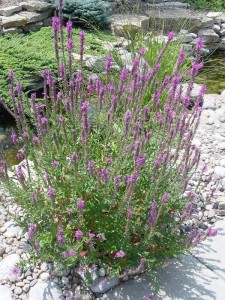Invasive Species
The most prevalent invasive species in the park are: Oriental Bittersweet, Japanese Knotweed, Tree of Heaven (Ailanthus), Purple Loosestrife, Garlic Mustard, and Multiflora rose. Poison ivy, which grows throughout the park, is a native plant.

Most of these were introduced to the area by horticulturists as garden ornamentals. An exception is garlic mustard, which was introduced as a food plant. Japanese Knotweed, Purple Loosestrife, and Oriental Bittersweet are particularly invasive and difficult to eradicate.
Introduced plants that become invasive have particular habits that make them more successful than native plants, for example a long growing season, long tap roots to reach water, chemicals that weaken neighboring plants, and ability to tolerate harsh conditions. These plants tend to crowd out the native plants that local wildlife need for food and habitat.
In the Conservation District, one instance of a native – invasive “mismatch” occurs when monarch butterflies lay their eggs on (invasive) black swallow-wort instead of native milkweed. Black swallow-wort is in the milkweed family, but the young monarch caterpillars cannot digest its leaves so they die.
For history and information on invasive plants in New England, see Invasive Plant Atlas of New England. For general information, please see www.invasive.org or invasivespeciesinfo.gov.
While you are enjoying the beauty of Blackstone Parks you may spot Invasive Species. Please use the link to the handy form below (and you can even upload a photo) to let us know where you see them.



